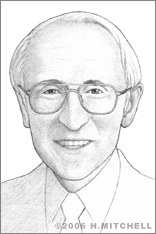Graeme Clark
Australian physician, scientist, and inventor Graeme Milbourne Clark changed the lives of tens of thousands of hearing-impaired individuals with his creation of the multi-channel cochlear implant. The device, also known as the “Bionic Ear,” has given people with severe to profound hearing loss, in more than 100 countries, the ability to communicate effectively in the world of sound by enabling them to hear and understand spoken language.
Born August 16, 1935, Clark grew up in Camden, a town near Sydney, Australia, where his hearing-impaired father worked as a pharmacist. Here, he observed first-hand the communication difficulties that come with hearing impairment. He completed his Bachelor of Medicine and Bachelor of Surgery degrees at the University of Sydney in 1957 and trained as an ear, nose, and throat surgeon in Australia and the UK before returning to the University of Sydney in 1967. He completed a Master of Surgery degree in Nasal Surgery in 1968 and a PhD in Neural Mechanisms in Hearing there in 1969.
In 1970, Clark was named the William Gibson Professor of Otolaryngology (head and neck surgery) at the University of Melbourne. He had, by then, already become focused on research related to the hearing nerves in the human cochlea, or inner ear, and the possibility of electrically stimulating those nerves in order to help deaf people hear. His challenge was to create an implantable device that could be surgically placed inside the ear without damaging the delicate nerves it was meant to aid. In addition to appropriate design for such a device, he also needed to establish audiological principles that would ensure that it worked correctly.
Clark discovered a way in which a tiny, implantable piece of hardware could process an acoustic stimulus into several frequency channels. Each of these separate signals would be used to apply electrical stimulation to various areas inside the cochlea. The device he created is essentially a miniature receiver-stimulator with multiple electrodes fed with power and speech data through two separate aerials, optimized for processing human speech. A prototype was first implanted in a patient in 1978. Its success proved for the first time that a safe, cochlear implant could enable deaf individuals to understand spoken language.
In 1979, the Commonwealth Government awarded Clark and his team a Public Interest Grant to fund commercial development of the device. The first successful clinical trial took place in Melbourne in 1982. That year, Cochlear Ltd. was formed to begin commercial production, and clinical trials began worldwide. Nucleus, Ltd., began commercializing the devices in 1983, and the U.S. Food and Drug Administration (FDA) approved them for general use in adult patients in 1985. A version for children aged 17 and under won FDA approval in 1990.
By 2002, the product had helped more than 35,000 people around the world. The device is said to be one of the most important advances for aiding deaf and hearing-impaired individuals since the advent of sign language.
Meanwhile, in 1984, Clark established the Bionic Ear Institute, where he has continued to conduct research into what are now generally known as “bionic ears.” Current research includes optimizing the cochlear implant for listening to music. He has also led research to develop new applications for the technology employed in his cochlear implants, including aiding in spinal cord repair and the treatment of other neural injuries.
Clark served as research leader at the Department of Otolaryngology at the University of Melbourne from 1970 until he retired in 2004 to become full-time director of the Bionic Ear Institute. He was also Head and Founder of the Cochlear Implant Clinic at the Royal Victorian Eye and Ear Hospital in Melbourne from 1985 to 2004.
He holds several patents, has authored over 350 papers, and has been recognized with hundreds of honors and awards in his home country and around the world. He received the Order of Australia in 1983 and was awarded the 1991 James Cook Medal, 1997 Sir William Upjohn Medal from the University of Melbourne (where he still teaches), the 2004 Australian Prime Minister’s Prize for Science, and the 2005 A. Charles Holland Foundation International Prize, among numerous other honors. He is a fellow of the Australian Academy of Science, the Royal Society of London, and the Australian Academy of Technological Sciences and Engineering.


